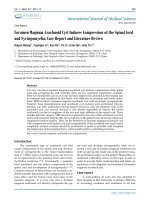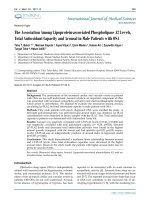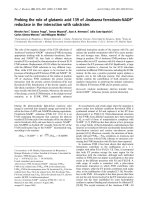Báo cáo y học: "he Association Among Lipoprotein-associated Phospholipase A2 Levels, Total Antioxidant Capacity and Arousal in Male Patients with OSA"
Bạn đang xem bản rút gọn của tài liệu. Xem và tải ngay bản đầy đủ của tài liệu tại đây (414.95 KB, 8 trang )
Int. J. Med. Sci. 2011, 8
369
I
I
n
n
t
t
e
e
r
r
n
n
a
a
t
t
i
i
o
o
n
n
a
a
l
l
J
J
o
o
u
u
r
r
n
n
a
a
l
l
o
o
f
f
M
M
e
e
d
d
i
i
c
c
a
a
l
l
S
S
c
c
i
i
e
e
n
n
c
c
e
e
s
s
2011; 8(5):369-376
Research Paper
The Association Among Lipoprotein-associated Phospholipase A2 Levels,
Total Antioxidant Capacity and Arousal in Male Patients with OSA
Taha T. Bekci
1
, Mehmet Kayrak
2
, Aysel Kiyici
3
, Emin Maden
4
, Hatem Ari
2
, Zeynettin Kaya
2
,
Turgut Teke
4
, Hakan Akilli
2
1. Department of Pulmonary Medicine, Konya Education and Research Hospital, Konya/ Turkey.
2. Department of Cardiology, Meram Medical Faculty, Selcuk University, Konya, Turkey.
3. Department of Biochemistry, Meram Medical Faculty, Selcuk University, Konya, Turkey.
4. Department of Pulmonary Medicine, Meram Medical Faculty, Selcuk University, Konya, Turkey.
Corresponding author: Taha Tahir Bekci, MD. Konya Education and Research Hospital, Meram 42090 Konya/Turkey.
Phone: +90 533 3787676. E-mail:
© Ivyspring International Publisher. This is an open-access article distributed under the terms of the Creative Commons License (
licenses/by-nc-nd/3.0/). Reproduction is permitted for personal, noncommercial use, provided that the article is in whole, unmodified, and properly cited.
Received: 2011.03.17; Accepted: 2011.04.25; Published: 2011.06.10
Abstract
Background: The mechanisms of the increased cardiac and vascular events in patients
with OSA are not well understood. Arousal which is an important component of OSA
was associated with increased sympathetic activation and electrocardiographic changes
which prone to arrhythmias. We planned to examine the association among arousal,
circulating Lp-PLA2 and total antioxidant capacity in male patients with OSA.
Methods: Fifty male patients with newly diagnosed OSA were enrolled the study. A
full-night polysomnography was performed and arousal index was obtained. Lp-PLA2
concentrations were measured in serum samples with the PLAC Test. Total antioxidant
capacity in patients was determined with Antioxidant Assay Kit.
Results: Arousal was positively correlated with LP-PLA2 levels (r=0.43, p=0.002) and
was negatively correlated with total antioxidant capacity (r= -0.29, p=0.04). Elevated
LP-PLA2 levels and decreased total antioxidant activities were found in the highest
arousal quartile compared with the lowest and 2nd quartiles (p=0.02, p=0.05, respec-
tively). LP-PLA2 was an independently predictor of arousal index in regression model
(β=0.357, p=0.002)
Conclusions: This study demonstrated a moderate linear relationship between arousal
and LP-PLA2 levels. Also, total antioxidant capacities were decreased in the higher
arousal index. Based on the study result, the patients with higher arousal index may be
prone to vascular events.
Key words: Obstructive sleep apnea, Arousal, Lipoprotein-associated phospholipase A2, total an-
tioxidant status, cardiovascular risk
Introduction
Obstructive sleep apnea (OSA) is independently
related with increased risk for hypertension, ischemic
stroke, and myocardial ischemia [1-3]. The mecha-
nisms of the increased cardiac and vascular events in
patients with OSA are not well understood. Arousal,
in the absence of hypercapnia or hypoxia, has been
reported to be associated with an acute increase in
sympathetic activity [4]. Arousals from sleep are as-
sociated with acute surges in blood pressure and heart
rate [5-7]. The repeated arousals from sleep that occur
in OSA may contribute to the increased risk of de-
veloping hypertension [1, 8], with the mediating fac-
Ivyspring
International Publisher
Int. J. Med. Sci. 2011, 8
370
tor being the frequent, acute cardiovascular insults
[9]. Arousal was also related with electrocardio-
graphic changes at the RR, QT and PR intervals
[10-12].
The measurement of circulating cardiovascular
risk factors (including several novel markers of car-
diovascular disease) enables a more accurate predic-
tion of cardiovascular risk to be made, as there are
clearly established relationships between levels of
various circulating haemostatic risk factors and a
subsequent cardiovascular event [13, 14]. In recent
years, several epidemiology studies have showed an
association among lipoprotein-associated phospho-
lipase A2 (Lp-PLA2), a biomarker that may be viewed
as a potential link between noxious effects of oxidized
LDL cholesterol and elusive plaque vulnerability,
cardiovascular and cerebrovascular events [15-21].
Increased oxidative stress and inflammation were also
demonstrated in patients with OSA [22]. Although,
the relation between arousal and cardiovascular
changes was known, the association among circulat-
ing LP-PLA2, total antioxidant capacity and arousal
has not been studied yet. We planned to examine the
association between circulating cardiovascular risk
markers and arousal in patients with OSA.
Methods
Patients who were referred to the Sleep labora-
tory for evaluation of sleep-disordered breathing
between April 2009 and January 2010 were prospec-
tively screened for the study. Fifty male patients with
newly diagnosed OSA were enrolled to the study but
women are not included in this study. OSA was de-
fined as an apnea-hypopnea index (AHI) of ≥5 ob-
structive events per hour of sleep. The patients who
did not meet exclusion criteria’s were consecutively
enrolled the study. Patients with hypertension, coro-
nary artery disease, heart failure, a history of stroke,
diabetes mellitus, chronic obstructive or restrictive
pulmonary disease, chronic renal disease,
dyslipidemias, pharmacologically treated depression,
and tobacco use within the past 10 years were ex-
cluded from the study. In addition, nightshift workers
and patients receiving medications or nutritional
supplements were ineligible for the study. The Selcuk
University Ethic Committee approved the study and
written informed consent was obtained from all study
participants.
Polysomnography
At least one full-night polysomnography (PSG)
was performed by using Compumedics E-series Sleep
System, (Compumedics, Melbourne, Australia). Elec-
troencephalography (EEG), submental electromyog-
raphy (EMG), leg EMG, electrooculography (EOG),
and electrocardiography (ECG) recordings were ob-
tained; air-flow was measured using both a nasal
cannula (NC) and nasal thermistor, oxygen saturation
(SaO
2
) was measured using a pulse oximeter, and
chest and abdominal respiratory movements were
monitored. A reduction in oxygen saturation to ≤ 4 or
the occurrence of symptoms of physiologic awaken-
ing, following at least a 30% reduction in air flow for a
minimum of 10 sec, was considered as hypopnea.
Individuals with an apnea hypopnea index (AHI) >5
were diagnosed as OSAS and included in the study.
Determining of Arousals
An arousal was defined as an increase in EEG
and/or EMG activity (frequency and amplitude) that
varies significantly from the background activity de-
fining the current sleep stage. An arousal was scored;
during NREM sleep consisting of an abrupt EEG fre-
quency shift (eg, alpha, theta, or frequencies >16 Hz,
but not spindles) lasting at least 3 s and accompanied
by at least 10 s of stable sleep. A REM arousal is
characterized by similar EEG changes but should be
accompanied by an increase in chin EMG that is at
least 1 s in duration. The arousal index is the number
of the arousals per hour of sleep [23].
Study Protocol
All subjects underwent attended nocturnal pol-
ysomnography in the sleep laboratory. Nocturnal
polysomnography was performed as previously de-
scribed. AHI was defined as the number of obstruc-
tive apnea plus hypopnea episodes per hour of sleep.
Weight, height, waist and hip circumference and
blood pressure of patients were measured. Other
demographics such as diabetes mellitus, hypertension
and smoking status were recorded. Body mass index
was calculated with formula. The patients were di-
vided into two groups according to median arousal
index as above or below median. The demographic
features and parameters of polysomnography test
were expressed as to median arousal. Venous blood
samples were drawn into serum separator clot acti-
vator tubes at 9:00 A.M. from patients after overnight
fasting within 48 hours of polysomnography.
Lp-PLA
2
Lp-PLA
2
concentrations were measured in se-
rum samples with the PLAC Test (diaDexus Inc, USA)
reagent kit on UniCel DxC 800 Synchron Clinical
System (Beckman Coulter, USA) automated clinical
chemistry analyzer. The PLAC test is a turbidimetric
immunoassay using two highly specific monoclonal
antibodies against Lp-PLA
2
. Lp-PLA
2
concentrations
Int. J. Med. Sci. 2011, 8
371
were given as ng/ml. Clinical and analytical sensitiv-
ities of the assay are 7 ng/ml and 4 ng/ml respec-
tively. Reference intervals suggested by the reagent
manufacturer are 120-342 ng/ml for females and
131-376 ng/ml for males. The assay is linear up to
500ng/ml without prior dilution. Intra-assay and in-
ter-assay precisions are %2 and %1,6 ( Control 1: 143,9
ng/ml) and %1,6 and %0,8 (Control 2: 449,8) respec-
tively. The patients were divided into four groups
according to arousal’s quartile. Arousal range of pa-
tients in the quartiles was defined as the lowest quar-
tile: 1.8-8.4, 2
nd
quartile: 8.8-14.1, 3
rd
quartile: 14.4-20.5,
the highest arousal quartile: 23.6-71.6. LP-PLA2 level
of each arousal quartile was compared. LP-PLA2 level
of > 200 ng/ml was accepted as an elevated LP-PLA2
[24].
Total Antioxidant Capacity
Total antioxidant capacity in patients was de-
termined with Antioxidant Assay Kit (Cayman
Chemical Company, USA). The assay relies on the
ability of antioxidants in the sample to inhibit the ox-
idation of ABTS
®
(2,2'-azino-di-[3-ethylbenzthiazoline
sulphonate]) to ABTS
®
· + by methmyoglobin. The
capacity of the antioxidants in the sample to prevent
ABTS oxidation is compared with that of Trolox, a
water-soluble tocopherol analogue, and is quantified
as mM Trolox equivalents. Samples containing anti-
oxidants between 0,044-0,330 mM can be assayed
without further dilution. Inter-assay and intra-assay
values are %3 and %3,4 respectively
Statistical Analysis
Data were analyzed by using SPSS software ver-
sion 13.0 (SPSS, Chicago, IL, USA) and were ex-
pressed as mean ± standard deviation. The seasonal
distribution of the variables was analyzed with Kol-
mogorov-Smirnow test. Correlation analysis was car-
ried out with Pearson’s correlation test for normally
distributed variables. Linear regression analysis was
performed to determine the predictors of arousal in-
dex. Firstly, linear regression analysis was performed
with enter method and later it was performed with
stepwise method. Independent Student’s t tests were
used for comparing differences of parametric varia-
bles between two groups. The difference between
nonparametric variables was tested by Mann Withney
U test. Kruskal-Wallis H tests were used for compar-
ing medians of continuous variables among quartiles
of arousal. When statistically significant differences
occurred, single posttest comparisons were per-
formed by using the Mann-Whitney U test with Bon-
ferroni correction for multiple comparisons. Differ-
ences in prevalence were tested by the nonparametric
chi-square test. p value of < 0.05 was considered as
statistically significant for all the tests.
Results
The ages of the participants were between 35-60
years (Mean±SD was 43.5±10.5 years). Patients were
divided into two groups according to the median
arousal value and patients’ characteristics and labor-
atory findings were demonstrated in Table 1.
LP-PLA2, total cholesterol and triglyceride levels
were increased in patients above median arousal and
TAC was reduced in these subjects. Other demo-
graphic and laboratory findings were comparable in
two groups. According to the arousal quartile, the
level of LP-PLA2 was increased in the highest arousal
quartile compared to the lowest and 2
nd
quartile
(p=0.02) (Figure 1). Thus, elevated LP-PLA2 values
were originated from the highest arousal quartile. In
addition, the number of patients with elevated
LP-PLA2 (>200 ng/ml) was increased in the highest
arousal quartile compared to the other quartiles (n=2,
n=2, n=3 and n=8, p=0.035, respectively from the
lowest arousal quartile to the highest arousal quartile)
(Figure 2).
In the stepwise linear regression model, a
LP-PLA2 level was independently associated with
arousal (p=0.002). Linear regression analysis with
enter method demonstrated that only LP-PLA2 levels
were related with arousal (Table 2), but hsCRP, total
antioxidant capacity, BMI, and age were not related
with arousal (Table 3).
The study demonstrated a significant negative
correlation between total antioxidant capacity and
arousal (r= -0.29, p=0.04). Also, total antioxidant ca-
pacity was decreased in the group of below the me-
dian arousal index (p=0.05) (Table 1).
Correlation analysis between LP-PLA2 and other
variables were demonstrated in Table 4.
Figure 1. It was demonstrated that LP PLA2 level was
significantly increased in the highest arousal quartile. *
p=0.02
Int. J. Med. Sci. 2011, 8
372
Figure 2. The distribution of patients with elevated LP PLA2 levels was demonstrated according to the arousal
quartiles in the figure. The most of patient with elevated LP PLA2 level were clustered in the highest arousal quartile.
*p=0.035
Table 1. Demographic features and laboratory findings according to the median value of arousals
Below the median arousal
(<14.25) n=25
Above the median arousal
(>14.25) n=25
p
Age 41,9±10,6 44,1±10,2 0.26
Smoker (n) 9 14 0.35
Hypertension (n)* 3 1 0.45
Diabetes mellitus (n) 2 1 0.68
BMI (kg/m
2
) 30,1±3,9 28,8±4,6 0.12
Waist / hip circumference ratio 0,96±0 ,04 0,95±0,06 0.83
Systolic Blood pressure (mmHg) 126,1±11,5 124,6±10,2 0.64
Diastolic blood pressure (mmHg) 74,4±5,1 75,8±7,6 0.44
LP-PLA2 (ng/ml) 152,0± 48,6
217,7± 100,5 0.005
hs-CRP (mg/dl) 3,1±3,8
3,2±2,7 0.90
TAC (mM) 1,36±0,53 1,03±0,51 0.05
Fasting blood glucose (mg/dl) 81,3±21,8 82,7±16,3 0.79
Total cholesterol (mg/dl) 184,0± 35,7 213,5±43,0 0,01
Triglyceride (mg/dl) 167,0 ±76,2 247,9±175,3 0.05
Creatinine (mg/dl) 0,92±0,12 0,92±0,11 0.83
AHI 35,4±21,7 29,1±25,1 0.35
Total sleep time (minute) 351,0± 62,7 330,1± 72,9 0.26
Lowest sat O
2
(%) 80,1±5,8 81,7±4,7 0.58
hs-CRP: high sensitive C-reactive protein, BMI: Body mass index, AHI: apnea-hipopne index, TAC: Total antioxidant capacity. *Hypertension
was defined as resting blood pressure ≥140/90 mmHg
Int. J. Med. Sci. 2011, 8
373
Table 2. Stepwise Linear regression analysis to determine of independent predictors of the arousal index
B Std. Error Beta t P
Constant 11.011 31.577 0.349 0.73
Age 0.246 0.209 0.165 1.175 0.25
Systolic BP (mmHg) -0.092 0.197 -0.064 -0.464 0.65
Apnea-hipopne index 0.151 0.092 0.231 1.638 0.11
Total cholesterol (mg/dl) 0.036 0.075 0.099 0.488 0.63
Triglyceride (mg/dl) 0.021 0.020 0.194 1.057 0.30
hs-CRP -0.038 0.664 -0.008 -0.057 0.96
LP PLA2 (ngml) 0.063 0.028 0.357 2.226 0.03
TAC (mM) -3.684 3.629 -0.141 -1.015 0.32
BMI -0.530 0.566 -0.156 -0.936 0.36
Dependent Variable:, R=0,59, R
2
=0,35, F
(9,46)
=2.20, P=0,04 (The first step of the stepwise linear regression model)
Constant 3.793 4.895 0.775 0.443
LP PLA2 (ngml) 0.077 0.024 0.437 3.259 0.002
R= 0.44, R
2
=0.21, F
(1,46)
=10.62, P=0.002 (the last step of stepwise linear regression model)
hs-CRP: high sensitive C-reactive protein, BMI: Body mass index. BP: Blood pressure, TAC: Total antioxidant capacity
Table 3. Correlation analysis between total arousal and
laboratory tests, demographic characteristics
r p
Age 0.12 0.38
BMI -0.20 0.19
Hip/waist circumference ratio 0.08 0.57
Systolic Blood pressure 0.07 0.65
Diastolic blood pressure 0.10 0.47
LP-PLA2 (ng/ml) 0.43 0.002
TAC (mM) -0.29
0.04
hs-CRP 0.06 0.66
Fasting blood glucose -0.10 0.50
Creatinin -0.09 0.51
hs-CRP: high sensitive C-reactive protein, BMI: Body mass index,
TAC: total antioxidant capacity
Table 4. Correlation analysis between LP-PLA2 and
polysomnography parameters, other laboratory findings
r p
Total arousal 0.43 0.002
Apnea index 0.03 0.832
Apnea-hypopnea index -0.08 0.573
Total sleep time -0.27 0.06
PLM index 0.49 0.001
Lowest saturation (%) 0.11 0.69
Age (years) 0.07 0.65
BMI -0.35 0.01
Waist / Hip circumference ratio -0.23 0.12
Systolic Blood pressure (mmHg) 0.20 0.17
Diastolic blood pressure (mmHg) 0.09 0.53
hs-CRP (mg/dl) 0.27 0.06
TAC (mM) -0.17 0.24
Fasting blood glucose (mg/dl) -0.07 0.65
Total cholesterol (mg/dl) 0.09 0.54
Triglyceride (mg/dl) 0.02 0.91
Creatinine (mg/dl) -0.19 0.21
hs-CRP: high sensitive C-reactive protein, BMI: Body mass index,
PLM: Periodic Limb Movement









